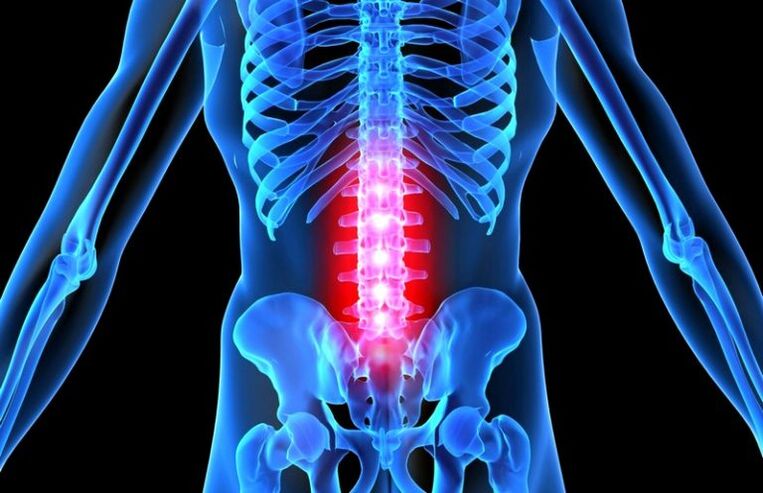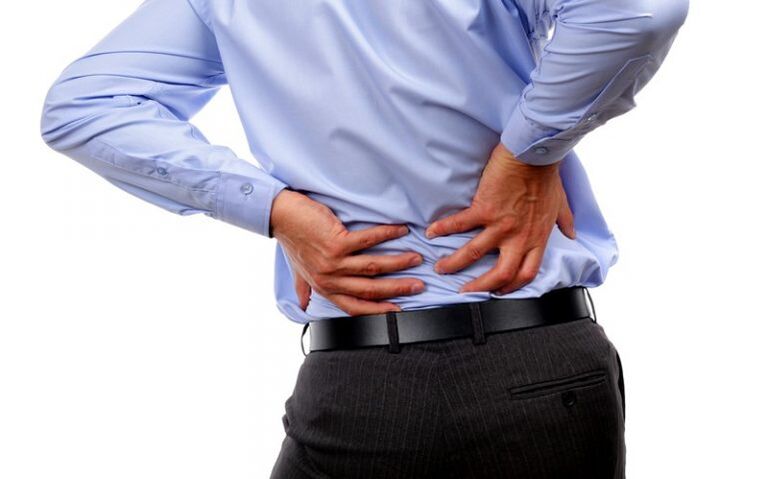
Translated from ancient Greek, osteochondrosis means bone and χόνδρος cartilage and is characterized by complex degenerative changes in skeletal joint elements. Almost every part of the skeleton is susceptible to this neurological disease. There may be chest and / or cervical vertebrae in the affected area. However, osteochondrosis of the lumbar spine, the symptoms and treatment of which are most common in modern conditions, is the cause of debate and concern among practicing neuropathologists.
Development of pathogenesis or inflammatory process
Any organism changes its physiology as it becomes an adult. Thus, as a result, diffuse changes occur in the vascular bed of skeletal intervertebral plates. Nutrient supply to the lumbar spine is complicated by various traumatic conditions and / or the constant dynamic load on this part of the spinal cord. Inadequate nutrition with the necessary micronutrients is further complicated by osteochondrotic processes that lead to loss of elasticity and strength of cartilage joints. In osteochondrosis of the lumbar spine, the symptoms of the disease are most active with the asymmetric and irrational work of the muscles of the spine, which are observed under different conditions:
- insufficient warming of muscle tissue;
- poor posture;
- congestion of intervertebral joints due to excessive adipose tissue;
- use of mattresses on a soft base during night rest;
- sharp mechanical and / or dynamic loads on the lumbar spine;
- physical stress;
- exacerbation of chronic pathologies.

Nutrient supply to the lumbar spine is complicated by various traumatic conditions and / or the constant dynamic load on this part of the spinal cord.
If lumbar osteochondrosis is detected, symptoms of neurological disease due to early medical intervention may lead to more severe nervous system pathologies such as sciatica, spinal hernia, intervertebral injury, and other complications.
Why does lumbar osteochondrosis occur?
To date, the problem of diffuse transformations in intervertebral space has not been fully investigated. With osteochondrosis of the lumbar spine, the symptoms of manifestations of neurological pathology are often felt in middle-aged people aged 35-45 years.

Nerve overload, stressful situations can also lead to the development of the disease.
At this most effective age, static and dynamic stress occurs on the spine. However, experts have observed that back pain is starting to bother more and more people in the younger age group. So already between the ages of 18 and 25, young people become patients in neurological treatment wards. This is due to poor physical activity, overweight, poor posture, and general deformities of the joints that cause lumbar osteochondrosis.
Symptoms and treatment of neurological pathology are desirable to identify and respond appropriately to the earliest stages of disease development.
Other causal factors leading to lumbar spine osteochondrosis are:
- hereditary forms;
- insufficient supply of micronutrients to cartilage vessels;
- violation of metabolic processes due to different circumstances;
- uneven development of the locomotor system;
- sedentary lifestyle;
- disorders of the body related to the work of the endocrine system;
- weakening of muscle structures due to the harmful effects of alcohol, smoking and other bad habits;
- a consequence of various chronic pathologies;
- segmental instability of spinal column elements;
- nervous overload, stressful situations and other components.
However, in the diagnosis of osteochondrosis of the lumbosacral spine, the symptoms of neurological pathology in women can be diagnosed due to the disorder of the body or the development of disorders associated with hormonal changes. At the age of 35-45, the female body undergoes significant physiological transformations that affect the functional work of all bone and cartilage areas of the spine.
Symptoms of the disease
In osteochondrosis of the lumbosacral region, symptoms of neurological pathology present with painful pain in the lumbar region, leading to numbness, discomfort, and pain in the lower back. Lack of proper therapy can complicate the situation and lead to complete atrophy of muscle structures in the lumbosacral spine. The increase in pain can be provoked by various factors such as sneezing, coughing, sharp turns and lifting heavy objects. Cuts in the lumbar region are most commonly seen in the gluteal region and the calf region of the lower limb. In lumbosacral osteochondrosis, the symptoms of neurological disease can be defined by the following signs:
- causes acute painful pain in the sacral spine region and pelvic organs;
- loss of sensitivity;
- discomfort in the innervated muscles of the lumbar spine;
- hypotension and hypotrophy.

All of these symptomatic signs result from damage to the nerve roots of the intervertebral plates of the lumbar spine.
Stages of the disease
When diagnosing lumbosacral osteochondrosis, the symptoms and treatment of the disease depend on the stage of the inflammatory process. Thus, the results of the diagnostic test indicate a number of specific signs of lumbar spine inflammation:
- The first stage is defined by mild sensations of pain in the lumbar zone, which are exacerbated by physical exertion. Only with sudden movements does the patient feel sharp, aching or dull pain in the lower back. At rest, no pain occurs.
- The second stage is defined as the distance between the vertebral discs decreases due to compression and the appearance of degenerative-dystrophic formations in the annulus fibrosus. The sharp pain radiating to the ankle region of the lower limb, buttocks, and thighs is due to the compression of the nerve endings between the plates in the vertebral space.
- Destruction of anulus fibrosus occurs in the third stage of the disease and is the most favorable time for hernia formation in the intervertebral disc. Intense pain in the lumbar region is constant due to significant deformity of the lumbosacral spine.
- The last, fourth stage of osteochondrosis of the lumbar spine, the symptoms, treatment and rehabilitation of which are the most difficult in the whole process of destruction of the musculoskeletal system. This stage of the disease leads to the disability of the patient as well as complete or partial immobility.
However, any form of osteochondrosis should not cause fear and panic in a person; only appropriate appropriate medical treatment is required.
Lumbar osteochondrosis: symptoms and medication
Based on the results of the symptoms and the diagnosis appropriate to the stage and form of the disease, specialists will select the appropriate drug treatment based on the use of pharmacological combinations in different directions. The key management goals for this issue are:
- slowing down degenerative-dystrophic processes in the lumbar zone by implementing appropriate therapeutic and prophylactic measures;
- elimination of functional disorders of spinal nerve endings;
- neutralization of painful feelings;
- functional restoration of muscle tone in the lumbosacral region;
- the patient's return to active life.
The age and sex of the patient as well as the condition of the endocrine system play a significant role in the choice of medication.
In drug exposure, the main focus is on pain relief by appropriate selection of pharmacological analgesics. Anti-inflammatory drugs allow it to neutralize destructive processes in the muscle structure of the spinal region. The most effective pharmacological agents are non-steroidal anti-inflammatory groups.

The most effective pharmacological agents are non-steroidal anti-inflammatory groups.
Anesthetics with hormonal supplementation and / or paravertebral blockade are used with the ineffectiveness of NSAIDs (non-steroidal anti-inflammatory drugs). In addition, the complex drug process includes other types of pharmacological drugs, such as sedatives, muscle relaxants, groups of drugs containing vitamins B1 and B12, which eliminate the compressive effect and ensure the supply of micronutrients to nerve tissues. After the end of the acute inflammatory period, drug therapy is terminated and other therapeutic and prophylactic measures are applied during the remission period.
Therapeutic prevention of lumbar osteochondrosis
You should be aware that treating osteochondrosis is a complex process that requires strict discipline and strict adherence to all of your doctor’s prescriptions. A prerequisite for complete recovery of the body is the completion of all stages of complex therapy, which includes:
- Massage that helps relieve muscle pain, restore blood circulation to problem areas of the lumbar spine, relieve muscle tension in these parts of the body.
- Physiotherapy is an excellent way to rehabilitate after an illness. The absence of side effects, the elimination of residual tensions in the lumbar region, are the advantages of physiotherapy procedures.
- Manual therapy is able to mechanically affect the muscle tissues of the lower back muscle and provide them with improvement in all vital processes.

It should be recalled that non-compliance with the recommendations of a neuropathologist for the complex therapeutic treatment of lumbar osteochondrosis is a possible encounter with the surgeon. In 90% of cases, surgery in the spinal stages is the result of a neglected condition of the disease and non-compliance with the doctor's recommendations.



























